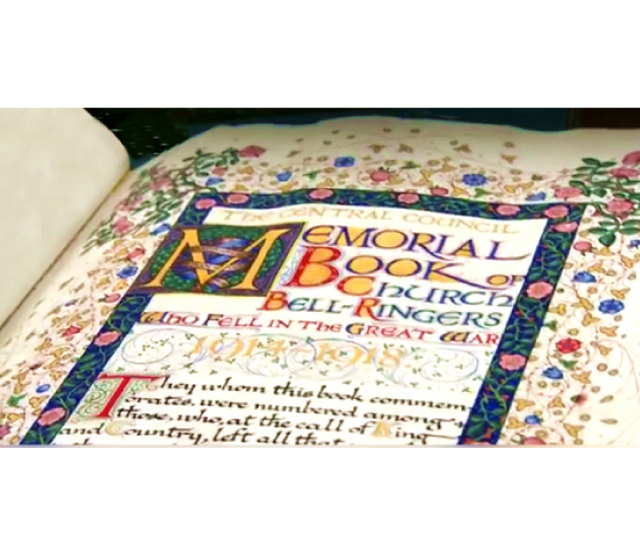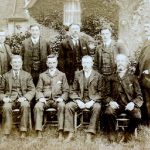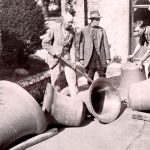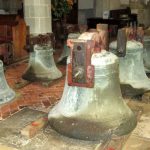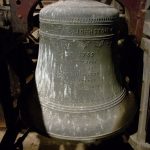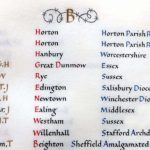During the First World War, the ringing of bells was used to spread news of the end of the conflict. Now for the war’s centenary they are being used again.
On 30th June 2016, bells rang out across Sussex from Chichester Cathedral and parish churches in towns and villages to commemorate the 100th anniversary of ‘The Day Sussex Died‘, the Battle of the Boar’s Head at Richebourg.
During the years of the Great War bell ringing had been severely curtailed by the Defense of the Realm Act (DORA). DORA, prevented the ringing of church bells and imposed restrictions on bonfires and after notable lights which could be used to signal enemy soldiers or spies. In Westminster even Big Ben had been silent since 1914. However, on 23rd November 1917, church bells rang out across the country in celebration for the first time during the war, following the success of the assault by tanks in the Battle of Cambrai.
Crowds gathered on the steps of St Paul’s Cathedral, London to witness the joyous sound of the bells ringing in celebration at the great victory of the Third Army breaking through the Hindenburg Line. St Paul’s 12 bells rang out for the first time in years and were soon joined by the bells of other churches across London and the cheers of the crowds.
- 5 Willingdon ringers enlisted and 4 returned
- Rehanging Willingdon Bells
Many bell-ringers had enlisted, which resulted in some 1,400 ringers losing their lives. In the early 1920s, the Central Council of Church Bell Ringers (CCCBR) sent out a call for the names of all ringers who had fallen in the war. They commissioned a handwritten Memorial Book, now in its second volume, to commemorate those ringers.
‘The Great War Memorial Book of Church Bell-Ringers who fell in the Great War 1914-1918‘, is on display in a bookcase on the way up to the ringing chamber at St Paul’s Cathedral. It bears the following inscription:
“They whom this book commemorates were numbered among those, who, at the call of King and Country, left all that was dear to them, endured hardness, faced danger, and finally passed out of the sight of men by the path of duty and self sacrifice, giving up their own lives that others might live in freedom.”
Over the years the Roll has grown as more names of ringers who died in the service of King and Country have come to light. In 1914-1918 not all church towers were registered with their County Associations and often it was men from those unregistered churches who were not originally recorded. In recent years, and especially during this 100th anniversary of the War, more research has been carried out as information has become more accessible.
Additional names have been sent in from churches, ringing societies and individuals, which Alan Regin, the current Steward of the Rolls of Honour, has collected and updated. The additional information now includes age, date of death, rank, regiment, and cemetery/memorial where known. A growing collection of photographs of headstones and memorials is also gradually being added. All this information can be viewed on the CCCBR website where an electronic version of the Roll is now available. Alan was awarded the M.B.E. in the 2018 New Year’s Honours List for ‘services to campanology and its heritage’.
The Sussex County Association of Change Ringers (SCACR), unlike some other Ringing Associations, doesn’t have its own Great War Roll of Honour displayed in a Sussex Church or other building. However, a record is kept and is available on their website listing names, age, church towers where they rang, regiment, rank and details of death, place of burial or commemoration. In 1919 the SCACR original roll commemorated 30 ringers from 14 church towers. Today this has risen to 49 from 21 towers with one additional name awaiting more research to be positively confirmed.
Several churches in Sussex list more than one ringer lost: Barcombe, Burgess Hill, Cuckfield, Henfield, Horsham/Warnham and Pulborough each lost three ringers. Four are listed from the churches of Mayfield and West Grinstead. The Westham bells were recast in 1921 and five names are inscribed on the tenor bell. It is thought that they were all bell-ringers at the tower who lost their lives although it doesn’t actually state this on the bell.
- Westham Bells – the Tenor front right
- The Westham Tenor Bell – Image courtesy of St Mary’s Church, Westham
- Nation Roll – page including Harry Burgess of Westham
All those named on the bell are on the Westham War Memorial except for one who is named on the Stone Cross memorial. One of those named is Harry Burgess (Private Henry Thomas Burgess SD/2864, 13th Batt. Royal Sussex Regiment) who was killed in action on 30th June 1916 at the Battle the Boar’s Head. Harry is the only Sussex bell-ringer recorded as having been killed on ‘The Day Sussex Died’. His brother George is also named on the tenor bell.
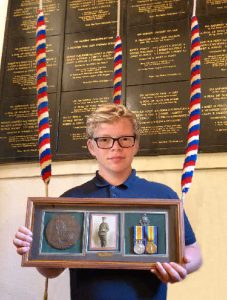
Willingdon bell-ringer with his great great great uncle Ernest Wooller‘s medals
Church bells across the UK remained very restricted throughout the course of the First World War and apart from a few exceptions, really only rang freely once Armistice was declared on 11 November 1918. With the 100th anniversary of the Armistice approaching this year, it is planned that the Nation’s bells will again ring out together from churches and cathedrals in cities, towns and villages across the United Kingdom as they did in 1918. Although silent at present due to restoration work, Big Ben will also strike at 11am to mark the centenary.
To mark this, the final year of the First World War centenary commemorations, it is hoped to recruit 1,400 new bell ringers in honour of the number that lost their lives during the First World War.
A campaign titled ‘Ringing Remembers‘, is being run by the Ministry of Housing, Communities and Local Government in collaboration with Big Ideas Community Interest Company and the Central Council of Church Bell Ringers. ‘Ringing Remembers’ aims to keep this traditional British art alive in memory of the bell-ringers who lost their lives in The Great War, thereby linking together bell-ringers of the past, present and future.
This story was submitted by Rosalind Hodge, Archivist, Willingdon Parish Church

